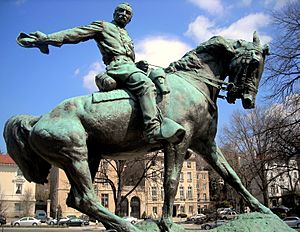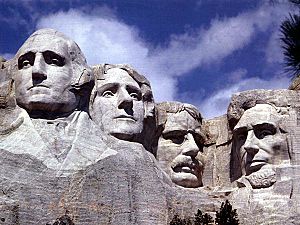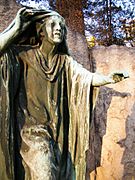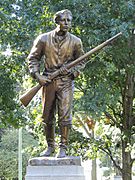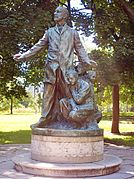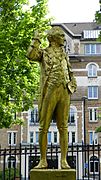Gutzon Borglum facts for kids
Quick facts for kids
Gutzon Borglum
|
|
|---|---|
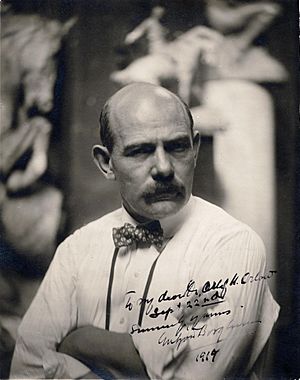
Borglum, 1919
|
|
| Born |
John Gutzon de la Mothe Borglum
March 25, 1867 St. Charles, Idaho Territory, U.S.
|
| Died | March 6, 1941 (aged 73) |
| Resting place | Forest Lawn Memorial Park, Glendale, California |
| Nationality | American |
| Education | Mark Hopkins Institute of Art Académie Julian École des Beaux-Arts California School of Design |
| Known for | Sculpture, painting |
| Movement | Bull Moose Party |
John Gutzon de la Mothe Borglum (born March 25, 1867 – died March 6, 1941) was an American sculptor. He is most famous for creating the huge carvings at Mount Rushmore.
Borglum also made many other public artworks across the United States. These include parts of Stone Mountain in Georgia and a statue of Union General Philip Sheridan in Washington, D.C. He also sculpted a bust of Abraham Lincoln. This bust was shown in the White House by President Theodore Roosevelt and is now in the United States Capitol crypt in Washington, D.C.
Contents
Early life and education
Gutzon Borglum was born in 1867 in St. Charles, Idaho. His parents were immigrants from Denmark. His father, Jens Borglum, was a woodcarver who later became a doctor.
The family moved often during Gutzon's childhood. They lived in places like Omaha, Nebraska and St. Louis, Missouri. Gutzon attended St. Mary's College, Kansas. Later, he trained in a machine shop and graduated from Creighton Preparatory School.
Artistic beginnings in New York City
In 1901, Borglum returned to the U.S. and settled in New York City. He sculpted figures for the new Cathedral of St. John the Divine. By 1906, the Metropolitan Museum of Art bought one of his group sculptures. This was the first time the museum bought a sculpture by a living American artist. He also became known for his portrait sculptures.
Family life
Gutzon Borglum married Mary Montgomery Williams in 1909. They had three children together. One of their sons, Lincoln Borglum, later helped his father with the Mount Rushmore project.
Public involvement and controversies
Borglum was involved in organizing the New York Armory Show in 1913. This show introduced modernism to American art. However, Borglum later left the committee. He felt the show focused too much on new art styles, making traditional artists seem old-fashioned.
He was also an active member of the Freemasons. He was friends with President Theodore Roosevelt for many years. During the 1912 presidential election, Borglum was a strong supporter of Roosevelt's Bull Moose Party.
Borglum had connections with the Ku Klux Klan, a controversial group. While it's not proven he officially joined, he attended their events. This involvement caused problems for his work. In 1925, he was removed from the Stone Mountain project because of disagreements, partly linked to the Klan.
Famous monuments
Borglum loved creating huge sculptures that celebrated American heroes. He believed that art should be "American" and honor American achievements. His large sculptures can be found across the United States.
In 1908, Borglum won a competition to create an equestrian statue of Civil War General Philip Sheridan. This statue is in Washington, D.C. A second version was put up in Chicago, Illinois, in 1923. President Theodore Roosevelt praised the Sheridan statue, calling it "first rate."
President Franklin D. Roosevelt dedicated Borglum's statue of William Jennings Bryan in 1934. This statue was later moved to Bryan's birthplace in Salem, Illinois.
In 1925, Borglum moved to Texas to work on a monument for trail drivers. He finished a small model, but the full-size statue was not made until 1940. It stands in San Antonio.
Stone Mountain carving
Borglum was first involved in carving Stone Mountain in Georgia. In 1915, he was asked to sculpt a memorial to Confederate heroes. He accepted, but told the committee that a small carving would look tiny on the huge mountain.
Borglum's plan grew into a massive carving of Generals Robert E. Lee and Stonewall Jackson, and President Jefferson Davis. They would be riding horses around the mountain. He also agreed to include a Ku Klux Klan altar in his plans.
Carving officially started in 1923. Borglum developed new ways to sculpt on such a large scale. He even used a giant "magic lantern" to project images onto the mountain. However, Borglum had many disagreements with the project organizers. In March 1925, he destroyed his models and left Georgia for good. None of his work remains on Stone Mountain today. But the techniques he developed there helped him with his next big project.
Mount Rushmore National Memorial
Borglum's most famous work is Mount Rushmore, which he worked on from 1927 to 1941. The idea for this monument came from South Dakota historian Doane Robinson.
The monument features the faces of four U.S. presidents: George Washington, Thomas Jefferson, Abraham Lincoln, and Theodore Roosevelt. Borglum used dynamite to remove large sections of rock.
His son, Lincoln Borglum, became his assistant sculptor. He oversaw the work when Gutzon was away. Gutzon Borglum traveled the world to raise money for the project. He also sculpted other memorials during this time, like a Thomas Paine memorial for Paris.
Gutzon Borglum died in 1941 due to complications from surgery. His son Lincoln finished another season at Mount Rushmore. The monument was mostly completed under Gutzon's guidance.
Other notable works
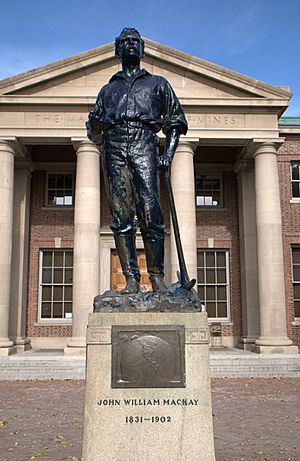
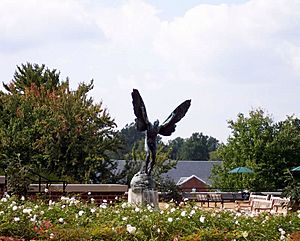
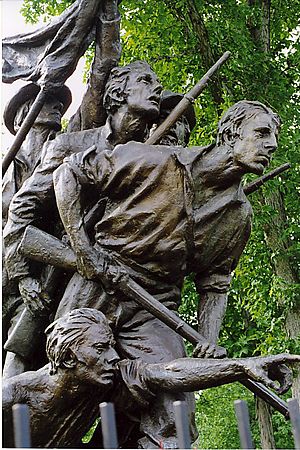
Some of Borglum's other important sculptures include:
- Rabboni (1909), a grave sculpture in Washington, D.C.
- Seated Lincoln (1911) in Newark, New Jersey.
- Indian and the Puritan (1916) in Newark, New Jersey.
- Wars of America (1926) in Newark, New Jersey.
- The Nathaniel Wheeler Memorial Fountain (1912) in Bridgeport, Connecticut.
- A memorial to Robert Louis Stevenson (1915) in Saranac Lake, New York.
- Aviator (1919), a memorial for a World War I pilot, at the University of Virginia.
- A statue of William D. Hoard (1922) at the University of Wisconsin.
- A statue of Collis P. Huntington (1924) in Huntington, West Virginia.
- A statue of Harvey W. Scott (1933) in Portland, Oregon, which was later removed.
- The Memorial to the "Start Westward of the United States" (1938) in Marietta, Ohio.
- A statue of Daniel Butterfield (1918) in New York City.
- A memorial to Sacco and Vanzetti (1928), a plaster cast of which is in the Boston Public Library.
- The North Carolina Monument (1929) at the Gettysburg Battlefield in Pennsylvania.
In 1918, Borglum helped write the Czechoslovak declaration of independence. In 1939, German troops destroyed his statue of Woodrow Wilson in Poznań, Poland.
Death
Gutzon Borglum passed away in 1941 from a heart attack. He is buried at Forest Lawn Memorial Park in Glendale, California.
Gallery
-
Bust of Abraham Lincoln, Crypt of the U.S. Capitol (1908)
-
Rabboni, Rock Creek Cemetery, Washington, D. C. (1909)
-
Thomas Paine, Montsouris, Paris (1936)
-
Memorial to Charles Brantley Aycock, North Carolina State Capitol (1941)
See also
 In Spanish: Gutzon Borglum para niños
In Spanish: Gutzon Borglum para niños
- Statue of John Campbell Greenway
- Sierra Madre, California
- James Patterson
- Chris Grabenstein
Other sources
- "Borglum, Gutzon". Encyclopædia Britannica (12th). (1922). London & New York: The Encyclopædia Britannica Company.


